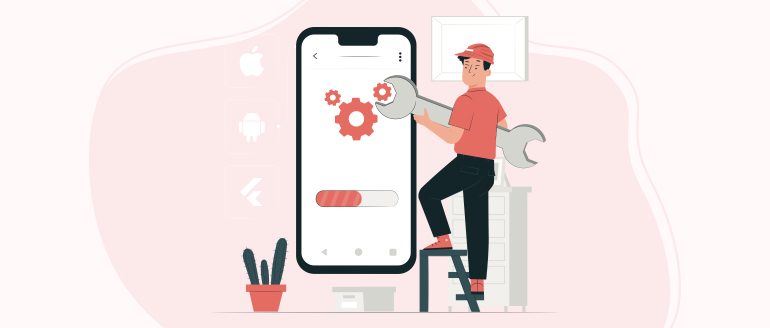The App development team creates superb mobile apps that everyone uses every day! Everyone can download any social network, messenger, game, or every other interesting app. And each of the apps is made by professionals who go over and over one path while creating.
Here, we’ll see who takes part in creating an app and what development team roles should be on the team to make a popular product.
Finding the Idea

A good application starts with a good idea. Think about the existing issues around you and possible solutions for them. Go through the options until you find a suitable market gap, and then look for the best way to fill it. Dive into the topic, collect data and schedule the discussion with your team. And then get down to business.
Start creating a working plan right after you have the idea. Check your competitors statistics to see how good or bad they perform. This will help you to understand how necessary your app will be. Also, it would be nice to read more about the competitor’s app and the case overall. This is a mobile app development basics since your team might face similar issues. And it is always better to check the process of others rather than failing yours.
Creating Design

After you’ve conducted research and created a working plan, you can start developing an app. Firstly, you’ll need the skills of your designers. Both UX and UI.
The app’s architecture depends on its functionality and the chosen method of processing and storing data. We usually make two lists for our projects: the characteristics that the application should have and the key visual elements. They become the foundation for all future architectural work.
Then we draw screens on a board or paper and place all the necessary elements, data, and all the basics there. It is at this stage that any changes can be made to the project.
Then UI designers create a mobile app style guide that should be as detailed as possible, based on audience characteristics. An experienced UI designer will offer hundreds of options for the color palette, fonts, and widgets (buttons, shapes, icons, etc.). As a huge part of the team mobile app, the designers will create every little detail that the rest of the team will work with.
And it is necessary to test all the designs after they are done. It will be highly pricy to omit the focus group so check the issues after your team has designed it.
Development Process

It’s time to cover the software development team structures. We must warn you, that in many cases business owners work with different companies so that the design team and development team don’t work together. It might slow down the development process, so we do recommend hiring a team that will be working on your project from the idea to the release date.
There is a myriad of technologies in mobile development. Some require almost no cost but do not result in high performance, others will require large investments to get a brilliant result. The worst thing you can do at this stage is to use outdated or unreliable tools, which will lead to rewriting the code and paying extra money to fix issues. It is easy to avoid when working with a skillful team mobile app.
Front End Development
There are three main approaches to frontend development team structure:
-
Native. The application is written for a specific mobile platform. That is, the application code for Android cannot be used on iOS without adaptation. The interface of the native application looks as organic as possible, and it works quickly and smoothly. Such reliability comes at a price, so native development is more expensive than other options.
-
Cross-platform. This means that the code will work on any OS as a native. Many consider this method to be optimal in terms of price-quality ratio, but it still requires the developer to spend time on optimization.
-
Hybrid. The code is written in HTML, CSS, or Javascript in development frameworks such as Cordova, PhoneGap, and Ionic. It turns out cheap and cheerful but with its downfalls.
Back End Development
You can’t create a profitable product without a back-end specialist in your mobile app development team structure. The server affects the performance of the mobile application and the scalability of the product, that is, the ability of the system to increase the same performance by increasing the available resources. The technologies are the same as in web applications development.
It is better to structure the work and pick the tools beforehand. The most popular are:
-
Coding. The specialist can write a mobile application in Java and SWIFT. To create a server, specialists need Javascript, C#, Go-lang, PHP, Python, and a dozen other languages. And each of them has frameworks for every taste.
-
Database management system. There are SQL and others. SQL systems are reliable and suitable for almost any task. The most popular are MSSQL, MYSQL, and PostgreSQL. The goal here is to make the system reliable and well-structured.
-
Server and API hosting. Consider the performance and scalability of the application along with its reliability and price in stores. Providers such as Amazon AWS and Rackspace offer cloud solutions for developers. And the size of the cloud can be increased as the user base grows. They will also help with data backup and online updates.
Mobile application development has many stages. It will be much easier to understand the stages and roles of each team member if you have heard about Scrum which is a project management method that involves breaking the workflow into small segments – sprints. Each of the sprints has stages of planning, development, testing, and debriefing.
Testing

The testing team selects the best way to test based on the characteristics of the product: its functionality, performance, and design.
And based on the app itself, the testing team will pick the methods to achieve the best result. The most used methods:
-
Regression testing
-
Platform testing
-
User acceptance testing
Now, the application should be completely ready and it’s time to work on the marketing part.
Marketing Team

This mobile app development team helps to understand the main challenge that every product has. Hundreds of high-quality apps are gathering dust on virtual shelves because their developers did not have a marketing strategy and budget for its implementation. Only B2B applications made for internal employees can work without a marketing team
Let your marketing team work with the target audience and see who will be engaged with your product more. And then release the app and start the promotion!
Final Thoughts
Even though the work seems hard, it’s not that hard when you break it down into smaller steps. Knowing all the development team roles and structure helps to build the flawless working process. That’s how you can hire a top-notch outsourcing team to build your app.
You can consult Owlab about outsourcing teams or check our Portfolio.